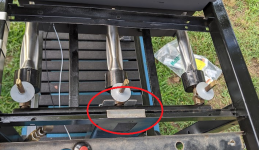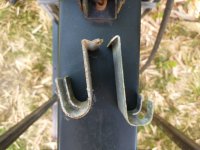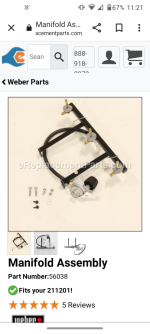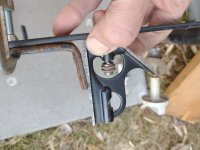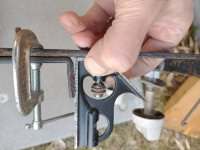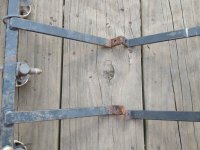You are using an out of date browser. It may not display this or other websites correctly.
You should upgrade or use an alternative browser.
You should upgrade or use an alternative browser.
Genesis Silver B manifold question
- Thread starter MikeAlt
- Start date
Steve Hoch
TVWBB Olympian
I wouldn't bend it while attached to the cookbox, it might shatter it. As LMichaels mentioned above, there is supposed to be a manifold support bracket installed to hold it up.
John G (Boston)
TVWBB Super Fan
Is it possible that the manifold came from an older grill? If I recall, the angle of an older cookbox is slightly different and will pitch the manifold a little.
Steve Hoch
TVWBB Olympian
Dan are you sure that's from a Genesis 1000? I've never seen that before, this is what it looks like on all my 1000's.The support bracket can be seen in this pic. Hooks over the underside crossbar and holds the manifold up. This is a Genesis 1000 but it is the same as a 2000 Silver B.
View attachment 68780
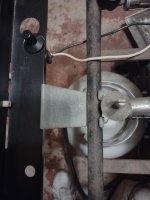
John G (Boston)
TVWBB Super Fan
The bracket Steve posted is a little later design. I think Dan's picture shows the earlier bracket, like what I found in the Junior. In fact, Dan's picture shows the same narrow crossmember as the Junior - which was eliminated in later grills. Here's a picture of the two brackets side-by-side. The Junior is on the left and a Silver series is on the right.
Attachments
Steve Hoch
TVWBB Olympian
Excellent, I think that explains it perfectly.The bracket Steve posted is a little later design. I think Dan's picture shows the earlier bracket, like what I found in the Junior. In fact, Dan's picture shows the same narrow crossmember as the Junior - which was eliminated in later grills. Here's a picture of the two brackets side-by-side. The Junior is on the left and a Silver series is on the right.
DanHoo
TVWBB 1-Star Olympian
I stole the pic from another post to show it as an example.
I've seen a few different shapes of the support brackets, but most are the newer style like what Steve showed.
And here are two manifolds both from silver Bs.
The square one to the left has the loops Bruce mentioned. It is from a 2002.
The one to the right is from a 2000 silver B, and it has the same support bracket as the later genesis x000s
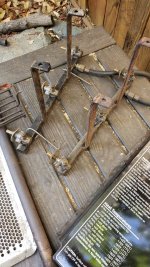
I've seen a few different shapes of the support brackets, but most are the newer style like what Steve showed.
And here are two manifolds both from silver Bs.
The square one to the left has the loops Bruce mentioned. It is from a 2002.
The one to the right is from a 2000 silver B, and it has the same support bracket as the later genesis x000s

Steve Hoch
TVWBB Olympian
DanHoo
TVWBB 1-Star Olympian
Even the new replacement manifolds for the 1000 series look yours on the left with the square fuel runner and hooks.
That's cool.
John G (Boston)
TVWBB Super Fan
Well, now I don't think so...Is it possible that the manifold came from an older grill? If I recall, the angle of an older cookbox is slightly different and will pitch the manifold a little.
I was out in the shed playing with stuff today and I took a few pictures. First, I think it might be pretty hard to put a 1000 manifold on a Silver (and vice versa). I didn't realize this but, the Silver mounting bolts are about 3/8 inch closer together than the 1000. In the picture below, titled "width", you can see the difference.
Next, I took the head off my little square and, best I could, tried to note the difference in the two angles. The 1000 is pretty near 90 degrees (probably is 90, give or take for the rust). The Silver is less than 90 (from the bending perspective - bent less than 90). This is the angle difference I was referring to in my (quoted above) post.
I'm thinking they made the change to eliminate the cast-in wedges on the 1000 cookboxs (maybe saved some cost? ) . The wedges make up for the slope in the cookbox wall - resulting in a horizontal manifold. The Silver cookboxes don't have these wedges so they just bent the mounting tabs on the manifold a little less to accommodate the slope - and still have the manifold end up horizontal.
I don't have any older Spirits (like the 700) at the moment but I'm wondering what they did on those grills. Did they have the cast-in wedges like a 1000? Are the mounting bolts the same width as a 1000? Or, are these aspects the same as a Silver? As Hank has said before, it looks like the Spirit cookbox was the predecessor to the Silver - while the 1000 was totally dropped.
Sorry to have geeked out here
Attachments

